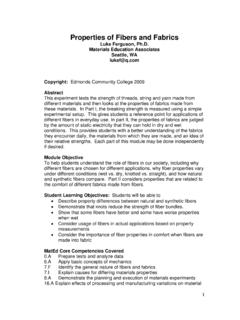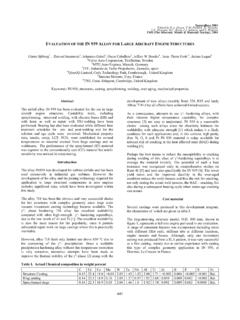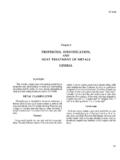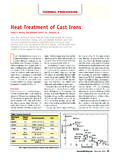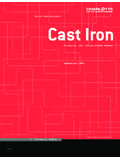Transcription of RubleAndrew - Cast Iron - Materials Education …
1 1 cast iron : History and Application Andrew Ruble Department of Materials Science & Engineering University of Washington Seattle, WA 98195 Abstract: This module introduces cast iron along with its varieties and applications. cast iron , like steel, is composed primarily of iron and carbon. However, cast iron s composition is near 4% weight carbon, which along with 1- 3% weight of silicon, greatly affects the microstructure of the iron and carbon, causing graphite, a crystalline form of carbon, to form instead of cementite (Fe3C). cast iron is divided into many groups and three are touched upon in this module: gray iron with graphite flakes, ductile iron with spherical graphite, and compacted graphite iron with wormlike graphite.
2 A discussion of properties follows and includes a hands- on activity that demonstrates the vibration damping of cast iron . Module Objectives: The objective of the module is to introduce cast iron , its structures and properties. After a brief history of metallurgy, the module will explain the formation of three types of cast iron , and their benefits. Students will be able to identify types of cast iron by micrograph. Lastly, the module aims to demonstrate the material property of vibration damping through a simple qualitative test. Student Learning Objectives: The student will be able to Identify cast iron , such as cast iron cookware Recognize properties which make cast iron useful Differentiate between cast iron alloys using a microscope Recognize cast iron through a vibration test MatEd Core Competencies Covered: Identify the General Nature of Metals Explain Causes for Differing Materials Properties Define and Describe Types and Properties of cast iron Describe Techniques used for Metals Processing 2 Key Words: Steel, cast iron , Carbon, Graphite Type.
3 PowerPoint presentation with lab or in- class demonstration depending on availability of equipment Time required: one class period, can include microscope viewings and vibration testing Suggested prerequisite: iron and Steel: Properties and Applications Target grade level: Advanced High School, Introductory College/Technical School Table of Contents: Abstract 1 Module Objectives 1 Student Learning Objectives 1 MatEd Core Competencies 2 Equipment and Supplies 2 Curriculum Overview 3 Hands on with Vibration Damping 8 Module Procedure 9 Evaluation 11 Supporting Materials 12 Acknowledgements 12 Equipment and Supplies Needed.
4 PowerPoint projection system cast iron samples, such as cookware cast iron microscopy samples, or micrographs (optional) Microscope (optional) 3 Curriculum Overview Although early civilizations could not produce fires hot enough to melt iron ore, they could heat and work the metal to remove impurities, and shape by hammering. This produced wrought iron ( wrought meaning worked ) which mostly kept the composition of the ore with an addition of carbon from the coals during heating. If even more carbon is added and the carbon content is raised to near 4 wt %, the melting temperature drops considerably (as seen in Fig.)
5 1) and makes melting iron feasible with early furnaces. This technique enabled early metallurgists to melt fully the iron ore and led to the first liquid iron that, cast easily into a variety of shapes, suitably named cast iron . Usually, the carbon in steel is in the interstitial sites or used for form cementite (Fe3C), a high hardness iron compound. In cast iron , the richer carbon phase facilitates graphite precipitation, a crystalline form of carbon. The advantage that cast iron has in graphite formation, instead of cementite, is not obvious at first. The graphite is considerably weaker than cementite and weaker than the iron around it, acting essentially as voids in the material, weakening the metal and reducing ductility.
6 The graphite flakes do offer non- mechanical advantages, such as vibration damping and wear resistance, along with being extremely cheap to produce. Figure 1: Fe- C phase diagram with the dotted line showing melting temperature. Notice the lower melting temperature of the liquid (L) as the carbon content increases, to about wt percentage C. 4 In addition to the high carbon content, a 1- 3% weight silicon added to the iron increases the potential for graphite formation, or graphitization. The presence of silicon also increases the fluidity of the liquid, which improves castability.
7 As cast iron techniques improved, other added alloying elements made cast iron stronger or more durable, while retaining its desirable characteristics. Elements such as magnesium, phosphorus, and cerium could be added for a variety of reasons but may decrease graphitization potential, which may necessitate the need for more elements to create a balance for graphite formation. Types of cast iron The physical shape of carbon in the iron matrix primarily determines the type of cast iron . Various types of cast iron were developed and extensive effort was made to influence the shape of the graphite in the cast iron by alloying, and heat treatment was used to alter the steel microstructure to improve mechanical properties.
8 The various types developed each have unique and specific commercial applications. The shape of the graphite also determines the mechanical response of the cast iron . Since the graphite is essentially a void, the stress concentration calculates like an elliptical crack, given the formula: != ! (1+2 ) where ! is stress at the crack tip, ! is stress applied, and a and b are length and width of the crack, respectively. This formula comes down to this: as a increases relative to b, stress concentrations at the crack tip also increase, and a higher stress concentration will allow crack propagation.
9 One can qualitatively estimate mechanical response for each type by comparing graphite geometry. Inversely, a cast iron s vibration damping properties increase with stress concentration. 5 Figure 2: Crack tip geometry affects stress at the crack, depending on a and b of the crack. Gray iron Historically, the first type of cast iron was gray iron , named for its gray color on the fracture surfaces. It is also the cheapest cast iron to produce. When graphite forms in gray iron , it produces flakes with sharp points within the iron matrix, such as seen in figure 2.
10 These sharp points lead to stress concentrations, like a sharp notch in a beam. As a crack forms, it will travel through these graphite flakes, and due to the flakes sharp points, continue to travel with ease. Due to this nature, the focus of gray iron engineering is on castability rather than mechanical properties. 6 Figure 3: A gray iron micrograph at 100x magnification. The points at the end of the flakes allow cracks to move through the metal. While gray iron is full of graphite flakes, it is still a strong material, especially in compression, and a high melting temperature.
